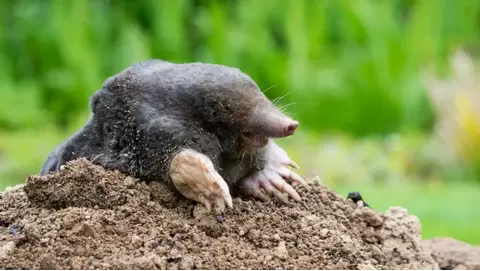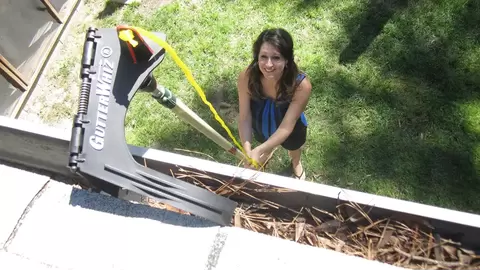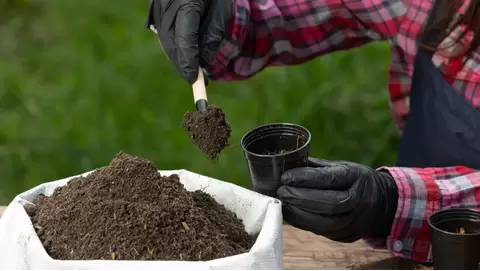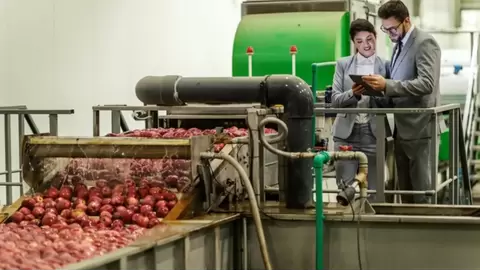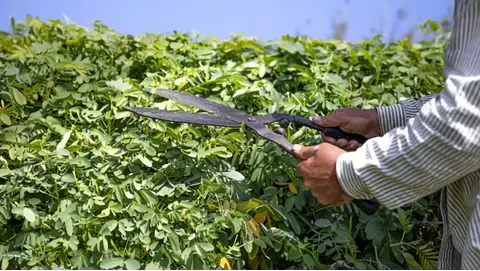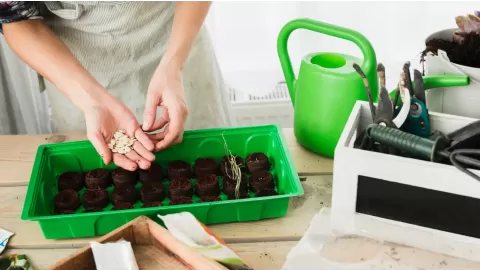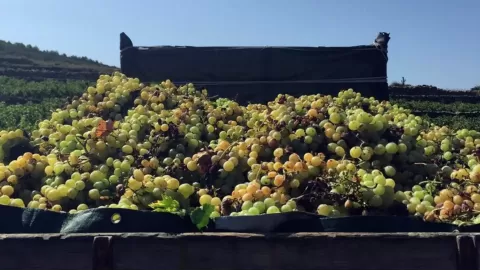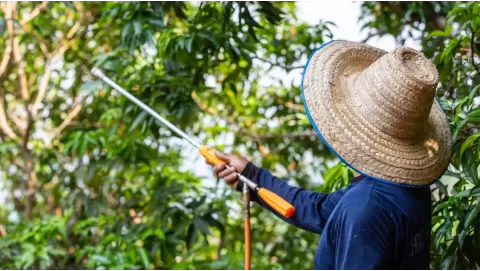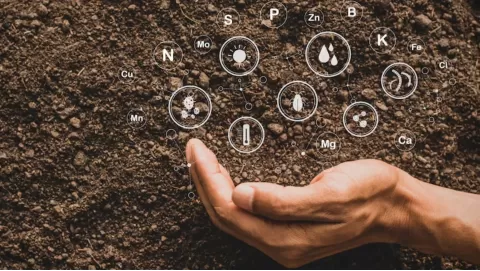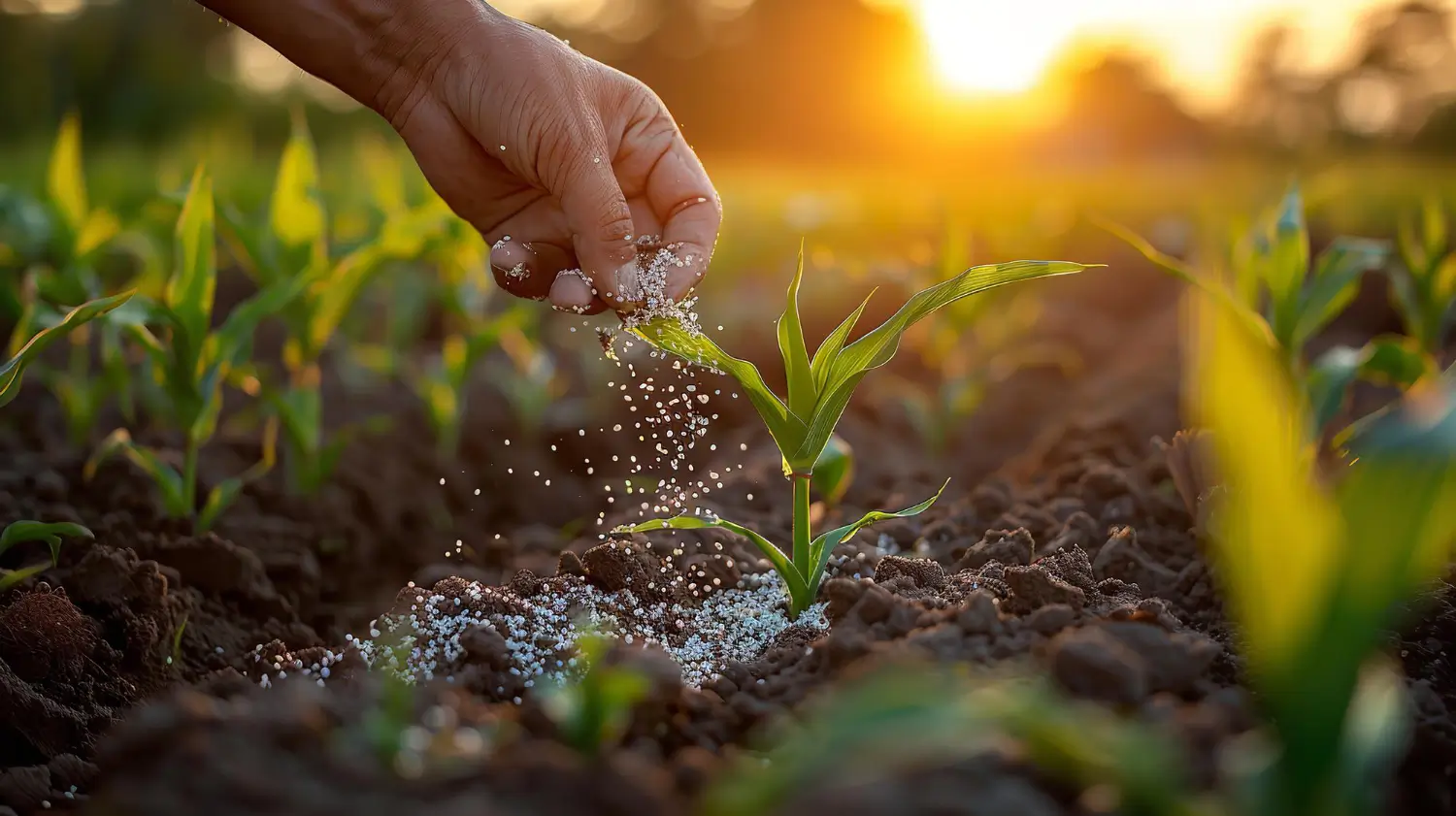
Understanding potassium fertilizers: Their role and benefits in plant health
Plants Potassium in plants is indispensable for nutrient management. In addition to phosphorus (P) and nitrogen (N), potassium (K) takes two important parts in the metabolism of plant cells. First it aids in the activation of enzymes plants need for their metabolic functions. Second, potassium is the “plant-preferred” osmoticum for water balance. In addition to this, potassium also helps in enhancing the quality of yield and in food formation by enhancing protein and starch formation in the plant.
The agricultural industry has come to rely so heavily on potassium fertilizers. These fertilizers are chemicals such as potassium chloride (KCl) and potassium sulfate that provide sufficient potassium to the plant for maximum growth. Soils are generally more fertile in K than N and P, but not inexhaustible due to substantial mining. Thus, potash application is one of the most important factors to retain soil productivity.
Maintaining high yields can be achievable with the right and adequate potash fertilization. Growcycle is a renowned merchant in the United States that specializes in horticultural and agricultural products for commercial growers. They offer the best fertilizers, including potassium, nitrogen, phosphate, etc., to make crops and gardens evergreen. Moreover, they provide a full range of solutions to meet the demands of contemporary growers.
What Are Potassium Fertilizers?
Potassium fertilizers, or Phosphates, are fertilizers that are derived from several potassium salts. All salts are purified to produce a variety of fertilizers. Potassium chloride and potassium sulfate are two of the most common K fertilizers derived from salt sources.
These fertilizers are designed primarily to increase plant strength, boost crop yields, and improve fruit, vegetable, and grain quality. They contribute to the regulation of stomata opening and closing, which automatically adjusts the loss of water vapor, oxygen, and carbon dioxide. Plant growth and yield suffer when K levels are inadequate or insufficient.
Symptoms of Potassium Deficiency in Plants
Potassium deficiency, also known as potash deficiency, is a plant disorder that is most common on light, sandy soils, because potassium ions (K+) are highly soluble and will easily leach from soils without colloids.
Any gardeners and farmers will have come across the following classic symptoms of plants not receiving enough potassium:
- Flamming and curling of leaf tips
- Yellowing in spaces among the veins of the leaves
- Formation of Purple spots on the underside of leaves
- Reduction in plant growth and development
- Increase susceptibility to diseases
In addition to these two symptoms, different pot plants have different symptoms of potassium deficiency. Such as;
Spider Plant: The tips of the leaves become brownish and dry. Older leaves may become yellow along the margins and may eventually become brown.
Peace Lily: Older leaves get yellow margins and eventually turn brown. Fewer flowers and smaller blooms.
Pothos: Older leaves are yellow but the veins are green. Leaves can curl under and be dry and crisp.
Snake Plant: They dry and become more prone to cracking. Brown, burnt-looking margins of the older leaves.
Fiddle Leaf Fig: Edges of old leaves, pots on the edge. Older leaves can fall off the plant.
Role of Potassium Fertilizers in Plant Growth
Potassium fertilizers play a crucial role in plant growth and overall health. Here's how potassium fertilizers contribute to plant growth:
1. Boost Photosynthesis and Energy Production
Potassium is vital for cell turgor and photosynthesis. Photosynthesis is how plants harness solar energy to produce carbohydrates, or sugars. Those sugars are composed of atmospheric carbon dioxide that has entered the leaf through stomata.
Stomatal opening and closing also occur with the help of potassium, which controls the exchange of water, carbon dioxide, and oxygen. In addition, potassium assists in the production of adenosine triphosphate (ATP), the energy currency of the cell, which drives the flow of energy in the plant.
2. Improve Water Regulation
Stomata are the small pores under leaves that remain open to let in carbon dioxide. Most of the water lost from the plant escapes through open stomata. Because K is required for the closing and opening of stomata, proper K supply allows the stomatal response in a timely manner. This enables plants to be well watered, reducing water loss in dry periods whilst ensuring efficient use of water.
3. Enhance Nutrient Transport
Potassium is an essential transport for water, carbohydrates and nutrients from roots to the stems of plants. It allows a plant to move the sugars it makes during photosynthesis in leaves to other parts so they can grow and develop. It also promotes the accumulation of oil and the formation of fatty acids in the seed to increase flourishing.
4. Help in Enzyme Activation
More than 60 enzymes, necessary for various biochemical processes in plants, are activated by potassium. The enzymes are active in numerous processes, including protein biosynthesis, starch synthesis, and cell division. It also stimulates glucose metabolism and enzyme activity and is required at virtually every step of the process; it also activates the enzyme responsible for the process.
5. Develop Stress Tolerance
Potassium is connected with Phytohormones; they interact with each other, and with other signaling molecules regulating biomechanical processes and metabolism, they elicit physiological responses regarding nearly all the traits of plant growth, and they enhance tolerance to stress. It also provides cell wall rigidity and enhances overall plant robustness to stress.
6. Boost Root Growth and Development
The total root development and growth were significantly associated with potassium. For hydro or soil to condition the soil and accelerate the vegetation. Potassium promotes cell division and elongation, the two most important activities in roots development. Potassium is the one that helps the roots to elongate and to develop strongly by promoting the growth of the root tip.
Types of Potassium Fertilizers
Various potassium fertilizers increase the growth and yield of the crop. The following is a list of usually applied potassium fertilisers.
1. Potassium Sulfate (K2SO4)
Potassium sulfate, commonly referred to as sulfate of potash or SOP, is a chlorine-free potash and sulfur fertilizer. It being composed of muriate, is expensive, per lb. It should only be used on high-value crops, such as potatoes, tomatoes, and market garden crops, as it has a content of 48–50% of K2O. It also contains 27% SO3. When applied to potatoes, it increases the dry matter content, resulting in better quality. But it’s also not as useful because of the price.
2. Potassium Nitrate (KNO3)
The inclusion of potassium and nitrogen in potassium nitrate means that it is an effective source of fertilizer to maintain balanced nutrition. It is widely used on fruit, vegetables, fertigation, and foliar spraying. It is meant for high-value crops because it contains 13% potassium and 44-46% K2O.
One way to apply KNO₃ to the soil is either before the growth season or as a supplement during it. Sometimes, plant leaves are sprayed with a diluted solution to encourage physiological processes or address nutrient deficits.
3. Muriate of Potash (KCl)
Muriate of potash or potassium chloride (KCl) is the most common K fertilizer. It supplies a pair of elements (potassium and chlorine) that are indispensable in both plant and animal nutrition. It comprises around 60% K2O. For most soils both these nutrients are readily accessible to crops.
KCl enhances the fertility of one or more other N and P-containing fertilizers upon the application to crops that are grown in arable farming, and it is usually granulated as a straight fertilizer (though some are available as a powder). It is abundant throughout the world and is extracted from rock deposits that are left behind when oceans entirely evaporate.
4. Sulfate of Potash Magnesia (K2SO4.MgSO4)
It is also called langbeinite and has kieserite and potassium sulfate content with 11% Mg, 18% K, 23% K2O content. For nonchloride materials that are magnesium-requiring crops, it is a good fertilizer to apply. In addition, it is ideal for plants like potatoes, tomatoes, and leguminous plants, which need potassium and magnesium, in turn strengthening roots and providing good yields.
5. Potassium Hydroxide (KOH)
In agriculture, potassium hydroxide is used for correcting the pH of soil. KOH is an inorganic compound. It is also known as potash caustic. This colorless solid makes a potent prototype base when combined with sodium hydroxide.
Potassium hydroxide increases the plant's resistance to root borne disease and As an agricultural chemical, in producing drinking water from water such as lakes and rivers, the mineral precipitate's absorption ability is affected by the source water's pH. In addition, potash is the highest value end product and improves food colour, texture, and taste.
6. Kainit, Sylvanite, and Potash Salts
These are frequently, depending on the source, composed of potassium, sodium,m and magnesium salts. You will typically have 12-30% K2O and 8-20% sodium (Na). These salts are particularly useful for a crop of sugar beets and other crops whose plants require salt.
Top Potassium Fertilizers
As we are aware that different crops have different requirements of potassium, therefore, the selection of the best and proper fertilizer becomes very important. While potassium fertilizers are relatively cheap, shop with trusted manufacturers to get the best/fittest material. The following unparalleled potassium fertilizers are available from Growcycle:
1. FRANKIA ORGANICS Potassium Sulfate
FRANKIA ORGANICS Potassium Sulfate is a fine-grade, outstanding, flowable product that is mined in Saskatchewan. This makes it simple to handle and apply in a variety of gardening and agricultural operations. Due to its 100% water solubility, plants can easily access potassium and sulfur, which immediately improves soil health and crop productivity. It contains 52% soluble potash and 18% sulfate, thus maintaining plant health, crop yield, and soil fertility.
Frankia's Potassium Sulfate has a fine texture similar to sand, making it easy to handle and ensuring it flows smoothly without clumping. This feature is especially useful for precise applications where it's important to spread the fertilizer evenly for the best results in plant growth.
2. Hi-Yield Muriate Of Potash
Hi-Yield Muriate of Potash is a great source of potassium, which is necessary to support strong tuber, stem, and root development in plants. It is very helpful for vegetables that form below ground, such as carrots, potatoes, and other plants. Use 1/2 lb. per 100 square feet or 1/2 lb. per 100 feet of crop row for application.
Muriate of Potash provides plants with the potassium they require to grow. Thus, it aids in strengthening root development, boosting drought tolerance, raising overall plant resistance to environmental challenges, and producing robust and abundant harvests. Please keep in mind that this product is not designed or advised for use with container-grown plants.
3. LAWN SYNERGY Potassium Fertilizer
LAWN SYNERGY Potassium Fertilizer is a potassium powerhouse containing a strong dosage of potassium, which is essential for fruiting, blooming, and general plant growth. It is well known for producing a lush landscape or preferred plants by providing the extra potassium required. This powerful fertilizer meets the various needs of vegetation and is ideal for lawns, gardens, veggies, and plants.
Additionally, this product is made with great care to achieve the highest purity level, so the plants will only receive the best. A 15-pound bag of Lawn Synergy potassium fertilizer may effectively cover 9,000 square feet to treat potassium deficiencies. For excellent results, apply 1lb of this potassium fertilizer per 1000 square feet.
4. Down to Earth Potassium Sulfate
Down to Earth Potassium Sulfate is the number one solution for all plant potassium requirements. It includes sulfur (S) and potassium (K), two key minerals for optimal plant growth and development. All significant physiological processes in plants rely on one or both of these nutrients.
Growers can confidently apply Down to Earth potassium sulfate since it provides a highly accessible water-soluble sulfate form and a high-performance solution-grade powder. This 200-mesh powder is designed for efficient distribution and rapid absorption, making it suitable for use in reservoirs, fertigation, drip irrigation, and spray applications.
Benefits of Potassium Fertilizers
The advantages of potassium fertilizers for plant growth and development are as follows. Here are some key advantages:
- Improve Yield Quality and Production
Adequate potassium levels contribute to increased agricultural yields and higher-quality products. Potassium brightens the size, color, flavor, and shelf life of fruits and veggies; it simply makes them more attractive and nutritious. It also transports nutrients, sugars, and starch from the leaves to other parts of the plants, promoting healthy growth.
- Develop Disease Resistance in Plants
Potassium helps with firming tissues of the plants, which aid disease and insect control. Plants that are healthy and well-fed are more resilient to disease and insects. Potassium alleviates many abiotic stressors, such as drought, salt, toxicity, high temperatures / low temperatures and so on. Increased K application has improved drought and disease resistance in certain crops.
- Help Maintain Osmotic Equilibrium
Through osmosis, water moves from a less salty region to a more salty region through a selective, or partially-permeable, membrane. In plants, much of the potassium is in the liquid inside the cell, which controls the salt concentration and water flow. So, it supports the osmotic balance and photosynthesis in plants.
- Improve Nitrogen Utilization
Sufficient potassium promotes nitrogen uptake and decreases amino acid and protein synthesis, thus resulting in higher yield, crop quality and nitrogen use efficiency (NUE). K-balanced fertilization increases agricultural yields and incomes, and improves NUE for environmental preservation. In addition, there is a need for adequate potassium (K) in the symbiotic interaction that allows bacteria to fix N from the air.
- Increase Tolerance to Drought
Application of potassium may alleviate the effects of drought stress on plant growth and development through its effects on root structure, exudates and soil microecology. The effect of K treatment may be due to an enhancement of the plant’s ability to maintain synthesis of response to photosynthetic and phytohormones under drought stress, thereby increasing the crop yield.
- Increase the Protein Content of Plants
Potassium assists in the activation of a number of plant enzymes directly involved in the synthesis of protein, such as adenosine triphosphate (ATP). Furthermore, potassium enables the good or effective use of nitrogen in the plant as it transforms the absorbed nitrogen into protein and amino acids. Poor nitrogen assimilation results when potassium is inadequate due to poor protein synthesis.
- Improve Starch and Sugar Translocation
Phloem translocation, or sugar translocation, equalizes sugar distribution in a plant. Potassium is needed for optimal transport of sugar, or carbohydrates from leaves to various parts of plants such as stems, fruits, seeds, roots etc. With sufficient potassium, sugar in plants can be evenly transferred, which promotes the growth and development of the body.
Methods to Apply Potassium Fertilizers
Knowing when and where to apply potassium fertilizers is also needed. Here are several promising methods to help make sure that plants maximize every drop:
- Soil Examination
One of the vital first steps is to apply all manures and commercial fertilizers before they are applied to crops. Carry out an analysis test of the soil to test the pH and potassium level of the soil. This is beneficial in determining what type of potassium fertilizer and how much potassium is needed to achieve the best plant growth possible.
- Pre-Planting
Evenly scatter a similar amount of potassium on the soil before planting, so that the plant has adequate nutrition during the critically important early development. This method is convenient, especially in potassium-poor regions.
- Top Dressing
For mature plants, use a potato top-dressing scheme of potassium fertilizer during the growth period to provide a constant nutrient source. This enhances the yield and availability of nutrients at all growth stages.
- Foliar Feeding
For foliar fertilizing - spray foliage directly and cover both sides of the leaves with potassium fertilizer. Such an approach may allow the correction of specific deficits and the rapid repletion of potassium. If plants have a potassium deficiency, gardeners or growers can use foliar feeding to provide them with potassium directly.
- Broadcasting
There is a general distribution of K fertilizer over the entire soil surface prior to planting or during plant growth. It is more appropriate for large farms and fields where even application of potassium is desired.
- Banding
In this application practice, potassium fertilizers are concentrated in bands near the row of the crop or below the seed at planting. That is good for leafy crops, for crops that like a quick availability of potassium or when strong application in the root area is required, as for example corn, potatoes, etc.
- Fertigation
This system dissolves potassium into water and is used in drip, sprinkler, and pivot applications. It is extremely beneficial for high-value crops like fruits, vegetables, and ornamentals, particularly in regions where water and nutrient application can be finely controlled.
- Monitoring and Adjustment
It is necessary to control and adjust regularly following the application of potassium fertilizers in order to ensure safety and durability. Inspect the plant for signs of potassium deficiency, such as weak stems and yellow leaf margins or poor fruit formation.
FAQs
What plants benefit from high potassium?
High potassium can help numerous plants, such as fruit crops such as grapes, peaches, and strawberries, and fruiting vegetables such as cantaloupes, watermelon, and tomatoes. In those plants, potassium will improve fruit size, sugar content, and resistance to diseases.
What is the best source of potassium for plants?
The finest potassium for plants comes from rock powder mined out of the earth and wood ash. Plants can also easily get potassium from potassium sulfate and potassium chloride as good sources.
When to apply potassium fertilizer?
The best time for potassium fertilizer application is in the fall or the early growing stage. Sandy soils' ability to hold potassium is limited due to their low cation exchange capacity. So, apply potassium closer to planting time because it is somewhat mobile in sandy soils.
The Bottom Line
For gardeners and agribusiness alike, potassium fertilizers are a kind of magic bullet. They have key functions in the enhancement of enzyme activation, photosynthesis, water balance, and nutrient transport. They may help moderate environmental stress induced by drought, diseases, and pests. A potassium deficiency in plants can affect the general texture and quality of a plant and slow its growth. Adding potassium fertilizers such as potassium sulfate or muriate of potash on a regular basis should also help with plant yield.
Growcycle provides the best quality potash fertilizers to ensure sustainable crop yields. With the appropriate fertilizer from their store, growers may boost the hardiness of their crops and ensure sustainability in top-quality yields for future success in agriculture.
Disclaimer: This material is for informational purposes only and should not be relied on for legal, medical, financial, or any other form of professional advice.


